Will the Supreme Court Extend the O’Connor Deadline?
Gregory Hood, American Renaissance, February 1, 2022
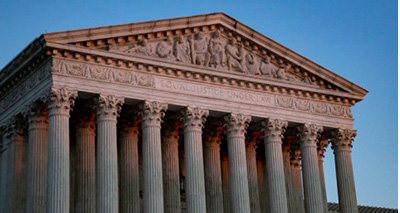
Credit Image: © Bryan Olin Dozier / NurPhoto via ZUMA Press
Justice Stephen Breyer of the Supreme Court’s liberal wing is retiring. This gives President Joe Biden a chance to nominate a “progressive” justice. He has promised to choose a black woman — affirmative action at the highest levels. New York Times columnist Charles Blow said there should be a nominee like Thurgood Marshall, whose “entire life was spent in the service of, and for the liberation of, Black people.”
Such a judge might defend anti-white racial preferences, or what’s delicately called “affirmative action.” The Supreme Court will soon decide whether “race-conscious admissions policies” at Harvard and the University of North Carolina are constitutional. It could mean the end of affirmative action.
The case that could end it is a consolidation of two suits filed by Students for Fair Admissions (SFFA), which has a big picture of an Asian student on its homepage. The cases were filed against Harvard and the University of North Carolina and arguments will be held this fall.
There is reason for optimism. Even after Justice Breyer is replaced, the Supreme Court will still have a 6-3 “conservative” majority. However, that’s no guarantee; “conservative” justices sometimes flinch at ending leftist policies.

Associate Justice of the Supreme Court Stephen G. Breyer announces his retirement in the Roosevelt Room at the White House in Washington on January 27, 2022 (Credit Image: © Yuri Gripas / CNP via ZUMA Press Wire)
Conservatives might also be forced to defend race realist positions if affirmative action goes. Professor Amy Wax of Penn Law School wrote earlier this month:
Without racial preferences, equal outcomes by race and the progressive ideal of racial “equity” in American society is not an achievable goal and will not be any time soon. More specifically, abandoning racial preferences and returning to colorblind, meritocratic standards will lead to significantly fewer low-performing minorities earning places in demanding professions and positions of authority.
Are affirmative action opponents ready, willing, and able to defend this situation without apology? Can they stomach the formidable task of justifying the group inequalities that will inevitably arise from applying colorblind, impartial principles?
Race realists can but conservatives probably can’t. They may simply conserve the existing order. In 2012, Republican nominee Chief Justice John Roberts changed his vote and saved “Obamacare,” reportedly to appear above politics and avoid a social and political battle.
The last time affirmative action came before the Supreme Court, it was a Republican appointee who saved it then, too. In Grutter v. Bollinger, the 2003 case that SFFA is challenging, Ronald Reagan’s nominee Sandra Day O’Connor was part of the 5-4 majority. She was also the first woman justice. She wrote the majority opinion, in which she argued that a “race-neutral” admissions process is the goal, but America isn’t ready: “We expect that 25 years from now, the use of racial preferences will no longer be necessary to further the interest that we approve today.”
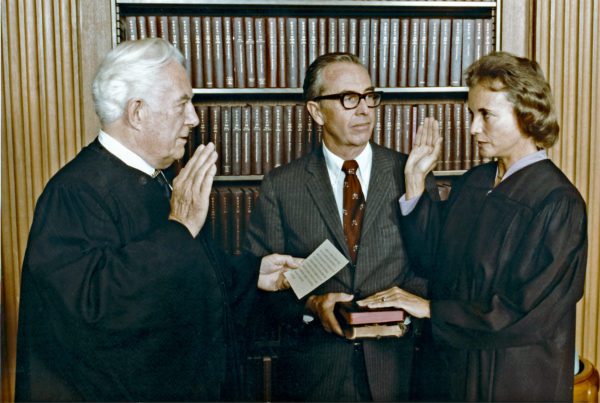
Sandra Day O’Connor is sworn-in as Associate Justice of the United States Supreme Court by Chief Justice Warren Burger in Washington, D.C. on September 25, 1981. Her husband John O’Connor, center, looks on. (Credit Image: © Michael Evans / White House / CNP via ZUMA Wire)
Justice O’Connor also wrote in the Grutter decision that the question of “whether diversity is a compelling interest that can justify the narrowly tailored use of race in selecting applicants for admission to public universities” was of “national importance.” Writing for the majority, she concluded that it was a compelling interest.
If diversity is good, there should be as much of it as possible. Promoting diversity and inclusion is now a $7.5 billion business, and that figure could double between 2020 and 2026. Ending affirmative action would cripple the industry.
However, Grutter also set up limits to how a race-conscious admissions system can be used. It cannot be a quota. Race must serve “only as a ‘plus’ in a particular applicant’s file.”
This muddled language sets up a nightmare of subjective decision-making. College admissions are a zero-sum game. There is no system in which race is only a plus that doesn’t hurt anyone.
Harvard and UNC cannot say that race is central to their admissions process without endangering their case. They must uphold the Grutter standard of claiming race is a “plus,” while also claiming that black and Hispanic numbers would fall so much without affirmative action that campuses would be starved of diversity’s benefits.
Similarly, SFFA must argue on the narrow ground that Harvard and UNC are exceeding the strict limits Grutter imposed on race’s role in college admissions. At the same time, SFFA is appealing to “colorblind” justice, arguing that race-based preferences violate the Civil Rights Act of 1964. If “colorblind” rules prevail, that is the end of the diversity industry.
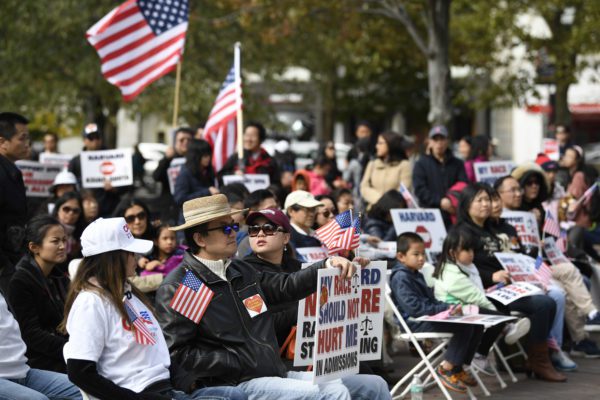
People demonstrate at the Copley Square in Boston, on Oct. 14, 2018. Hundreds of Asian Americans held demonstrations in central Boston to show support for a lawsuit accusing Harvard University of discriminating against Asian American applicants by using ”de facto racial quotas, racial stereotypes and higher standards.” Harvard has denied the charges. (Credit Image: © Liu Jie / Xinhua via ZUMA Wire)
Affirmative action’s defenders in this case are rapturous about diversity’s benefits. “The University has embraced diversity, in all its forms, as a core feature of its educational mission” reads the third sentence in the University of North Carolina’s brief. Citing a 2017 report from the university’s provost, the filing tells us these benefits include “promoting the robust exchange of ideas, fostering innovation, and preparing effective leaders.” Others claim that diversity prevents “groupthink,” prepares students for a multicultural world, and helps them understand people with different life experiences.
UNC “closely measures its progress toward achieving diversity’s educational benefits.” Though it has made “significant progress, its efforts to achieve the educational benefits that flow from a diverse student body are not finished.” Not having enough minorities “limits learning opportunities for all students.” UNC must therefore boost enrollment of “underrepresented minorities, who are admitted at lower overall rates than their white and Asian counterparts.”
A group called “Respondent Students” filed a brief defending UNC. It calls itself “a multiracial, multiethnic group of talented, ambitious students and now alumni.” Respondent Students says that “their educational experiences have been enriched by the racial and ethnic diversity at UNC.” Someone named Andrew Brennan wrote that “he became aware of islamophobia [sic] on UNC’s campus after attending a campus vigil held for the murder of three Muslim students.” Another testified that “exposure to diversity is necessary to prepare future leaders.” “SFFA [Students for Fair Admission] did not submit evidence contesting these benefits,” says the filing.
Harvard’s filing also claims benefits “flow” from diversity, and that it can’t be achieved without race preferences. It commissioned a study that “concluded that there currently are no workable alternatives that would allow Harvard to achieve the educational benefits of diversity while also maintaining its demanding standards of excellence.” Harvard says the district court ruled in its favor partially because “a heterogenous student body promotes a more robust academic environment with a greater depth and breath of learning, encourages learning outside the classroom, and creates a richer sense of community.” Diversity’s supposed benefits include promoting cross-racial understanding, preparing students “for an increasingly diverse workforce and society,” and providing “substantial social benefits” such as elites who are considered legitimate because “the path to leadership [is] open to talented and qualified individuals of every race and ethnicity.”
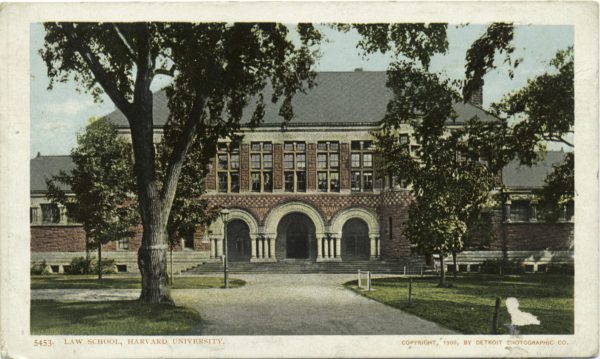
Harvard University (Credit: Album / quintlox)
“SFFA offered no rebuttal” to claims about diversity’s “profound educational benefits,” says Harvard’s brief. Later, it said that SFFA had “defaulted on this point” because “it declined to put on any evidence contesting the benefits of diversity.” This is true. In its December 21 filing in the USC case, SFFA does not deny diversity’s benefits. It mentions it only twice, and assures the Court that a race-neutral admissions process wouldn’t rob students of diversity’s benefits.
However, in its initial petition to the Supreme Court in the Harvard case, SFFA said that Grutter’s diversity rationale is based on “racial stereotyping” because it assumes members of a race all have the same experience. “It [a university] cannot simply use ‘race as a proxy’ for certain experiences or views.”
SFFA’s filings also say that the current situation benefits whites because of admissions preferences for alumni, staff, and donors. In the Harvard case, SFFA said that under a simulated race-neutral system without such preferences, “white admissions would decrease, combined African-American and Hispanic admissions would increase, Asian-American admissions would increase, and socioeconomic diversity would dramatically improve.” The implication is that a fairer admissions system will mean fewer white students.
In its initial filing in the UNC case, SFFA writes that “Grutter . . . [unfairly] treats underrepresented minorities not as the beneficiaries of racial preferences, but as instruments to provide educational benefits for other, mostly white students.” Later, SFFA decries racial discrimination because it hurts Asians. “The disparities that Asian-Americans face compared to their white peers are so stark that, when SFFA showed the data to a high-school counselor in Harvard, she started crying in her deposition.”
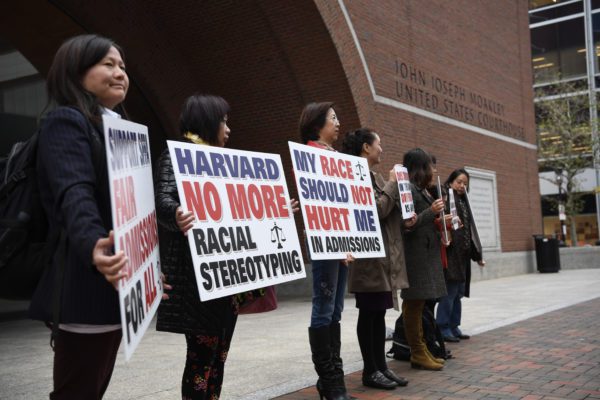
Credit Image: © Liu Jie/Xinhua via ZUMA Wire
Would stark differences in admissions standards for blacks and whites induce tears? Probably not. Asian-Americans are hurt by affirmative action too, but their pain matters more. Asians must be our proxies in this battle. In fact, the case seems like one giant proxy battle. The justification for affirmative action is that diversity adds value, and that goal isn’t even being challenged.
The examples of its benefits given by UNC and Harvard are unconvincing. Diversity, far from challenging groupthink, is part of a repressive, intolerant environment. Race-based activists composed of every group besides whites dominate campus politics. Rather than liberating them, diversity has turned students into commissars.
The court will not be considering that. Instead, it will decide whether the benefits of diversity — which no one challenges — can be had without considering race. It will also be considering whether the Constitution allows those benefits to be achieved by considering race.
That may be enough. The current subjective college admissions system is unstable. It’s time for honesty, and an open quota system would be preferable to what we have now. If the Court can’t stomach quotas, perhaps it will finally abolish affirmative action.
Some may think social peace requires affirmative action, and the diversity industry is powerful. Chief Justice Roberts’s salvation of “Obamacare” hints that he’ll look for a reason to save the industry. He might explicitly extend the 25-year O’Connor Deadline, which will be reached in just six years.

President Bush announces Supreme Court nominee John Roberts to be Chief Justice of the Supreme Court during a statement in the Oval Office Monday September 5, 2005. (Credit Image: © Chuck Kennedy / TNS / ZUMAPRESS.com)
Despite Justice O’Connor’s clearly expressed preference, affirmative action gets more blatant all the time. Being “colorblind,” is, according to white privilege theorists, itself proof of racism. Conservatives often bemoan “wokeness,” but they are doing little to abolish preferences.
He failed to end them, but President Ronald Reagan at least spoke against race preferences. Some Republicans oppose affirmative action because it hurts Asians. Asians supported President Biden by 63 percent to 31 percent in the last election but there are signs their loyalty is weakening. If Republicans help end affirmative action it could attract Asians.
Race realists know that the O’Connor Deadline has no end. Blacks and Hispanics will want more concessions from a white minority, not fewer. Race relations are becoming worse with more contact, not better. Even the alleged benefits from diversity, such as being able to communicate with others, ring false in a world of “microaggressions” and “problematic” speech.
For diversity to justify anti-white and anti-Asian discrimination, it would have to have huge benefits. SFFA fails to deny those illusory benefits and has therefore lost half the battle without a fight. This case will therefore be about whether colleges can meet a murky legal standard and whether race preferences hurt Asians. Will the justices be swayed by legal arguments? Will they think boosting blacks and Hispanics isn’t worth it if it means hurting Asians? Will they decide that racial discrimination of any kind in admissions is unconstitutional? Or will they decide that in an era of Black Lives Matter, they better leave affirmative action alone? Whatever happens, diversity-worship and the interests of whites aren’t even under discussion.















